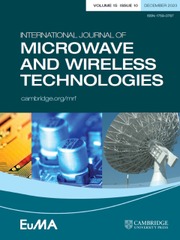Wideband and high-gain circularly-polarized L-shaped slot antenna array using metamaterial
Published online by Cambridge University Press: 02 July 2020
Abstract
This research involves a compact wideband circularly-polarized antenna array, which consists of a sequential rotating phase feed network, 2 × 2 mushroom-type metamaterial (MTM) unit, and so on. Each antenna array unit contains a microstrip feedline, an L-shaped slot antenna, and so on. The MTM-based antennas were incorporated with a sequential-phase network of sequentially rotated series-parallel feed to achieve wideband operation. The operational bandwidth and the radiation model in the high-frequency area were improved through the adjustment of spacing between the L-shaped slots while maintaining the size and structure of the MTM. The proposed design had dimensions of 80 mm × 80 mm × 3.5 mm (~1.64 λ0 × 1.64 λ0 × 0.072 λ0 at 6.15 GHz), and it was simulated, fabricated, and tested.
Information
- Type
- Metamaterials and Photonic Bandgap Structures
- Information
- International Journal of Microwave and Wireless Technologies , Volume 13 , Issue 4 , May 2021 , pp. 359 - 364
- Copyright
- Copyright © Cambridge University Press and the European Microwave Association 2020
References
- 5
- Cited by


